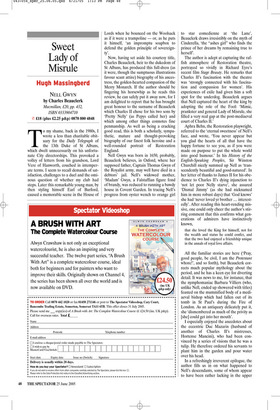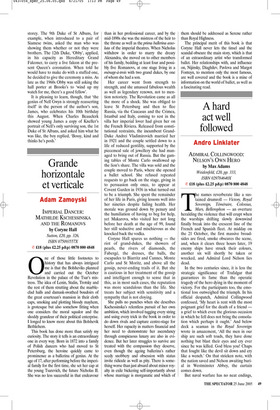Sweet Lady of Misrule
Hugh Massingberd
NELL GWYN by Charles Beauclerk Macmillan, £20, pp. 432, ISBN 0333904710 ✆ £18 (plus £2.25 p&p) 0870 800 4848 To my shame, back in the 1980s, I wrote a less than charitable obituary for the Daily Telegraph of the 13th Duke of St Albans, which dwelt unnecessarily on his unfortunate City directorships. This provoked a volley of letters from his grandson, Lord Vere of Hanworth, couched in intemperate terms. I seem to recall demands of satisfaction, challenges to a duel and the ominous question of whether my club had steps. Later this remarkable young man, by then styling himself Earl of Burford, caused a memorable scene in the House of Lords when he bounced on the Woolsack as if it were a trampoline — or, as he puts it himself, ‘an impromptu soapbox to defend the golden principle of sovereignty’.
Now, having set aside his courtesy title, Charles Beauclerk, heir to the dukedom of St Albans, has produced this full-dress (as it were, though the sumptuous illustrations favour scant attire) biography of his ancestress, the golden-hearted companion of the Merry Monarch. If the author should be fingering his horsewhip as he reads this review, he can safely put it away now, for I am delighted to report that he has brought great honour to the surname of Beauclerk which Charles II chose for his two sons by ‘Pretty Nelly’ (as Pepys called her) and which among other things connotes fine penmanship. As well as being a cracking good read, this is both a scholarly, sympathetic, mature and thought-provoking biography of our finest folk heroine and a well-rounded portrait of Restoration England.
Nell Gwyn was born in 1650, probably, Beauclerk believes, in Oxford, where her supposed father, Captain Thomas Gwyn of the Royalist army, may well have died in a debtors’ jail. Nell’s widowed mother, ‘Madam’ Gwyn, a Falstaffian figure fond of brandy, was reduced to running a bawdy house in Covent Garden. In tracing Nell’s progress from oyster wench to orange girl to star comedienne at ‘the Lane’, Beauclerk draws irresistibly on the myth of Cinderella, ‘the “ashes girl” who finds the prince of her dreams by remaining true to herself’.
The author is adept at capturing the raffish atmosphere of Restoration theatre, portrayed so vividly in Richard Eyre’s recent film Stage Beauty. He remarks that Charles II’s fascination with the theatre was ‘strongly connected with his fascination and compassion for women’. His experiences of exile had given him a soft spot for the underdog. Beauclerk argues that Nell captured the heart of the king by adopting the role of the Fool: ‘Mimic, prankster and general Lady of Misrule, she filled a very real gap at the post-mediaeval court of Charles II.’ Aphra Behn, the Restoration playwright, referred to the ‘eternal sweetness’ of Nell’s face, and wrote, ‘You never appear but you glad the hearts of all that have the happy fortune to see you, as if you were made on purpose to put the whole world into good humour.’ In his History of the English-Speaking Peoples, Sir Winston Churchill nicely summed up Nell as ‘transcendently beautiful and good-natured’. In her letter of thanks to James II for his obedience to Charles II’s dying injunction to ‘not let poor Nelly starve’, she assured ‘Dismal Jimmy’ (as she had nicknamed him in more robust days) that ‘God knows’ she had ‘never loved yr brother ... interestedly’. After reading this heart-rending missive, one could only cheer the author’s stirring comment that this confirms what generations of admirers have instinctively known,
that she loved the King for himself, not for the wealth and status he could confer, and that the two had enjoyed a friendship unique in the annals of royal love affairs.
All the familiar stories are here (‘Pray, good people, be civil, I am the Protestant whore!’, and so forth), but Beauclerk corrects much popular mythology about the period, and he has a keen eye for diverting detail. It was news to me, for instance, that the nymphomaniac Barbara Villiers (who, unlike Nell, ended up showered with titles) feasted on the mummified body of a mediaeval bishop which had fallen out of its tomb in St Paul’s during the Fire of London. As an antiquary delicately put it, she ‘dismembered as much of the privity as [she] could get into her mouth’.
I especially enjoyed the anecdotes about the eccentric Duc Mazarin (husband of another of Charles II’s mistresses, Hortense Mancini), who had been convinced by a series of visions that he was a tulip. He therefore ordered his servants to plant him in the garden and pour water over his head.
In a refreshingly irreverent epilogue, the author fills us in on what happened to Nell’s descendants, some of whom appear to have been rather lacking in the upper storey. The 9th Duke of St Albans, for example, when introduced to a pair of Siamese twins, asked the man who was showing them whether or not they were brothers. The 12th Duke, ‘Obby’, applied, in his capacity as Hereditary Grand Falconer, to carry a live falcon at the present Queen’s coronation. When told he would have to make do with a stuffed one, he decided to give the ceremony a miss. As late as the 1960s Obby was still asking the hall porter at Brooks’s to ‘wind up my watch for me, there’s a good fellow’.
It is pleasing to learn, though, that ‘the genius of Nell Gwyn is strongly reasserting itself’ in the person of the author’s son, James, who celebrates his 10th birthday this August. When Charles Beauclerk showed young James a copy of Kneller’s portrait of Nell’s only surviving son, the 1st Duke of St Albans, and asked him what he was like, the boy replied, ‘Bossy, kind and thinks he’s posh.’



































































 Previous page
Previous page